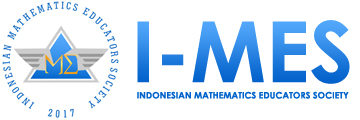MODEL PEMBELAJARAN DIRECT INSTRUCTION DALAM MENINGKATKAN PEMAHAMAN KONSEP DAN HASIL BELAJAR DEFINISI LIMIT BAGI MAHASISWA
DOI:
https://doi.org/10.35706/sjme.v1i1.549Abstract
Pemahaman konsep definisi limit perlu dimiliki oleh mahasiswa yang menempuh matakuliah Kalkulus. Pemahaman konsep mahasiwa yang rendah dapat menyebabkan hasil belajar mahasiswa juga rendah. Salah satu upaya untuk mengatasi permasalahan tersebut yaitu dengan melakukan pembelajaran menggunakan model pembelajaran Direct Instruction. Penelitian dilakukan di Universitas Hasyim Asy’ari Jombang dengan subyek penelitian yaitu mahasiswa Matematika semester IV. Pendekatan penelitian yang digunakan adalah pendekatan kualitatif dengan jenis Penelitian Tindakan Kelas pada matakuliah Kalkulus Peubah Banyak. Hasil menunjukkan bahwa model pembelajaran Direct Instruction dapat meningkatkan pemahaman konsep dan hasil belajar mahasiswa.Downloads
References
Arnika, D., & Kusrini. (2014). Penerapan model pembelajaran langsung (direct instruction) dengan metode kumon pada materi persamaan lingkaran di SMAN 1 Krian. Mathedunesa, 1(3), 1-6. Diperoleh dari http://ejournal.unesa.ac.id/article/9904/30/article.pdf.
Buyukkoroglu, T., Cetin, N., Deniz, A., Duzce, S. A., Maher, N., et al. (2014). The effect of computers on teaching the limit concept. International Journal for Mathematics Teaching and Learning, 7, 1-12.
Andriani, S. (2012). Pengembangan bahan ajar praktikum kalkulus melalui program maple untuk meningkatkan penalaran dan representasi mahasiswa. Atikan, 2(2), 295-312.
Duru, A. (2011). Pre-service teachers perception about the concept of limit. Educational Sciences: Theory & Practice, 11(3), 1710-1715
Elistina. (2014). Penerapan model pembelajaran langsung (direct instruction) berbantuan gambar untuk meningkatkan hasil belajar siswa pada mata pelajaran ipa di kelas V SDN 5 basi kecamatan Basidondo Tolitoli. Jurnal Kreatif Tadulako Online, 4(9), 148- 159.
Gultom, S. (2003). Pengembangan kurikulum kalkulus 1 di jurusan matematika FMIPA universitas negeri Medan. Journal pendidikan sians, 27(3), 20-29.
Hidayati, A. N. (2012). Efektivitas model pembelajaran direct instruction terhadap hasil belajar matematika materi pokok himpunan peserta didik kelas VII semester II smp islam miftahul huda kabupaten Jepara tahun ajaran 2011 - 2012. (Skripsi, IAIN Walisongo, 2015). Diperoleh dari http://eprints.walisongo.ac.id/id/eprint/951
Juter, K. (2007). Student’s conceptions of limits: high achievers versus low achievers. TMME, 4(1), 53-65.
Magliaro, S. G., Lockee, B. B., Burton, J. K. (2005). Direct instruction revisited: A key model for instructional technology. Educational Technology Research and Development 53(4), 41-56.
Noeruddin, A. (2014). Implementasi model pembelejaran kooperatif tipe stad disertai pemberian umpan balik berbasis contextual teaching and learning (CTL) untuk meningkatkan hasil belajar mahasiswa pada mata kuliah kalkulus peubah banyak ikip pgri Bojonegoro. Media Prestasi: Jurnal Ilmiah Stkip Pgri Ngawi, 13(1), 31- 41.
Pusfandari, A. D. A. (2014). Penerapan model pembelajaran langsung untuk meningkatkan hasil belajar matematika siswa kelas III SDN Ngagel rejo III/398 Surabaya. JPGSD, 2(2), 1-7.
Tashdiqy, R. H. (2015). Peningkatan pemahaman konsep belajar matematika melalui model pembelajaran direct instruction (DI) untuk siswa kelas XI smk muhammadiyah kota Pekalongan (Skripsi, Universitas Muhammadiyah Surakarta, 2015). Diperoleh dari http://eprints.ums.ac.id/32947/19/09%20NASKAH%20PUBLIKASI.pdf.
Downloads
Published
How to Cite
Issue
Section
License
Copyright (c) 2016 SJME (Supremum Journal of Mathematics Education)

This work is licensed under a Creative Commons Attribution-ShareAlike 4.0 International License.
Authors who publish with this journal agree to the following terms:
- Authors retain copyright and grant the journal right of first publication with the work simultaneously licensed under a Creative Commons Attribution License that allows others to share the work with an acknowledgment of the work's authorship and initial publication in this journal.
- Authors are able to enter into separate, additional contractual arrangements for the non-exclusive distribution of the journal's published version of the work (e.g., post it to an institutional repository or publish it in a book), with an acknowledgment of its initial publication in this journal.
- Authors are permitted and encouraged to post their work online (e.g., in institutional repositories or on their website) prior to and during the submission process, as it can lead to productive exchanges, as well as earlier and greater citation of published work (See The Effect of Open Access).











